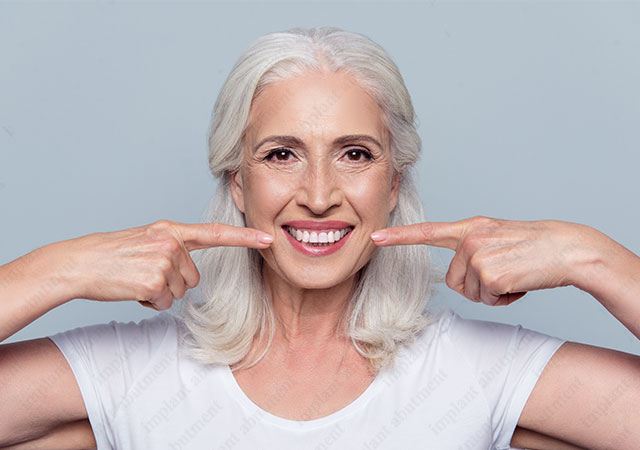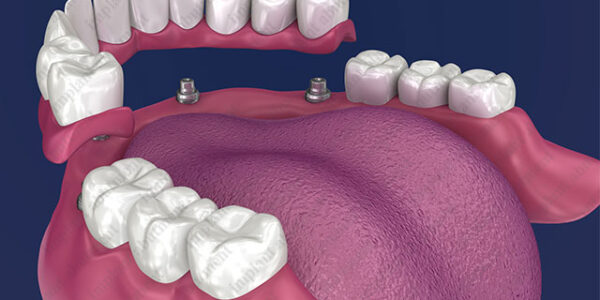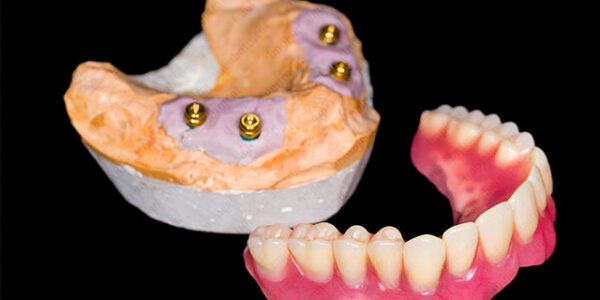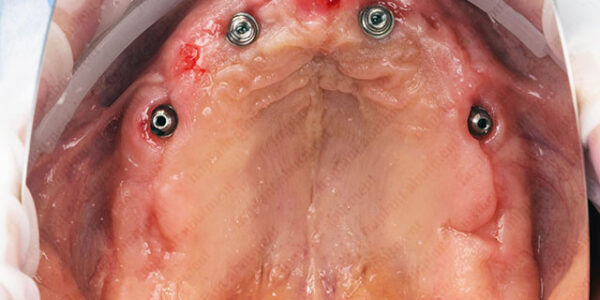An introduction to dental abutments
Before we get into what multi-unit implant abutments are, first let’s cover what a basic dental abutment is. An abutment is one of several components of a dental implant restoration that serves as the connection between the dental implant and the prosthesis. It is made from a durable, biocompatible material which is most often titanium, but one can also find abutments made of surgical-grade stainless steel, zirconia, cast gold, and polyether ether ketone (PEEK). The abutment also enables the prosthesis to be switched out without needing to also remove the implant and disrupt the healed tissue around the implant site.
What is a multi-unit abutment?
If we imagine the abutment as a musician, the multi-unit abutment (MUA) creates a small musical group — most often a quartet. So exactly what is a multi-unit abutment? MUA’s are abutments specifically designed to be used in multiple-implant scenarios where an entire arch is replaced. The multi-unit abutment is also the abutment most frequently used with zygomatic implants, which are implants that anchor to the zygomatic bone, rather than the maxilla bone, and can be an advantageous implant scenario in the case that the quantity or quality of maxillary bone is insufficient or inadequate.

When an entire arch is replaced, multiple implants are embedded into the patient’s jaw, and to attach the overdenture, the abutments must be angled appropriately to support the prosthesis, which is where multi-unit abutments come in. The quartet of MUA’s is known as an All-on-4 restoration, and there are also restorations known as All-on-6 and All-on-8, which employ six and eight implants, respectively. We’ll touch more on All-on-X implant systems in just a bit. Multi-unit abutments are available in a range of angulations and sizes, and the choice of these MUA characteristics is dependent on several factors, including the type of dental implant and the intra-oral environment of the patient.
Types of multi-unit abutments: straight vs. angled
The two main categories of MUA’s are straight multi-unit abutments or angled multi-unit abutments. Obstacles such as unique tooth angulations or alignments and varying bone conditions can create the need for different abutment angulations in a single multi-unit restoration. In these cases, the straight multi-unit abutment is not appropriate for certain implant sites and an angled multi-unit abutment must be used instead. In terms of angled multi-unit abutments, certain angulations are found commonly across most implant brands: 0°, 17°, 30°, and 45°. You may also come across less common sizes that are reserved for more specialized restorations, such as 52.5° and 60°. With these angulations, dental professionals are able to create a specialized restoration system for each patient based on the unique topography of his or her mouth.
The multi-unit abutment’s benefit over the standard abutment
In the case of the All-on-X system
The multi-unit abutment is a great resource for maximizing the design of an All-on-X restoration, and while not always necessary in every scenario, is most often recommended and sometimes required. Why would your dentist, periodontist, or dental implantologist choose to use MUA’s over a standard abutment? We mentioned earlier that the angulations of the multi-unit abutment can help with individual intra-oral topography. This is incredibly advantageous for patients who have any teeth misalignments or uneven/compromised bone in the jaw, and employing differently-angled MUA’s can correct any of these misalignments and result in an even, level restoration.
In the case of height disparities
In order to have a properly seated overdenture attachment, your dental implantologist may find that a single size of abutment is not sufficient. Height disparities that arise from implants being at different levels in the jaw due to variations in the bone can require the need for different abutment collar heights for two or more of the abutments in a multi-unit system. The goal is to achieve a universal height across all abutments in a single arch on which the overdenture can be placed and on which force is evenly distributed. With a properly and evenly seated overdenture, the resulting risk of micromovement or misfit can be greatly minimized. With this proper seating of the prosthesis, the restoration not only lasts longer, but patients are able to normally perform functions such as chewing, eating, talking, laughing, kissing and smiling with what feels like a real set of teeth.
How to use a multi-unit abutment
As with all abutments, placement of the multi-unit abutments is done only after post-surgical healing of the implant site is complete. At this time, an impression can be taken to obtain the necessary prosthetic. Below are the general steps to take when placing a multi-unit abutment, but make note that these steps will change slightly depending on whether a straight multi-unit abutment or angled multi-unit abutment is used, and whether the impression system is an open-tray or closed-tray system.
The basic steps of how to use a multi-unit abutment:
Step 1: Remove the healing abutment by counterclockwise rotation with a screwdriver.
Step 2: Using the appropriate tool, screw the abutment into the implant until resistance is felt, but do not tighten. This step is to check that the fit of the abutment is correct, so a radiograph is often performed to confirm that the abutment is properly seated in the implant.
Step 3: Once it is confirmed that the abutment is properly seated, it may then be tightened.
Step 4: The next step is to take an oral impression, either a standard impression or digital impression by intraoral scan in the case of working with CAD/CAM equipment. This will then allow the dentist or laboratory to design the necessary prosthesis in the case of a new restoration, or to make the correct adjustments on an existing prosthesis to convert it from a traditional bridge or denture to an implant-supported system.
Step 5: While the prosthesis is being made (whether in-house or being sent out to a laboratory), connect either a temporary restoration or healing cap to the multi-unit abutment.
The takeaway on multi-unit dental abutments
The multi-unit abutment is a game changer for overdenture prosthetic systems. By providing an array of collar heights and angulations that can work together to support a single overdenture unit, the superstructure and stability of the restoration is drastically improved, which in turn contributes to increased longevity and minimization of loosening and misfit risks. Furthermore, the opportunity for full-arch edentulous patients to have a screw-retained rather than cement-retained prosthesis has a significant impact on their quality of life.





